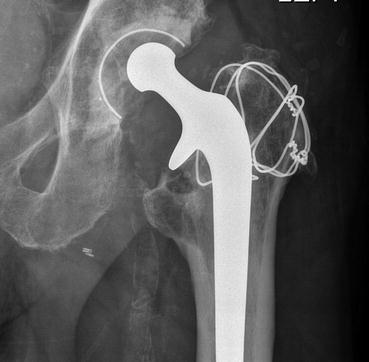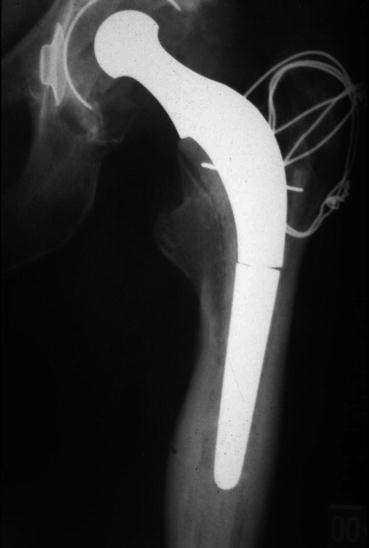, Paul D. Siney1 and Patricia A. Fleming1
(1)
The John Charnley Research Institute Wrightington Hospital, Wigan, Lancashire, UK
From the brief description of the role of the femoral component in general, and its intramedullary portion in particular, it is clear that loosening of the stem may be anticipated. It is the detailed study of failures that is an essential aspect of continuing evolution of the Charnley concept.
Inadequate Fixation
The aim of total hip arthroplasty is not only pain relief but also restoration of patient’s activity level. Walking is the highest load to which the hip joint is subjected, other than occasionally. It must, therefore, follow that in some situations fixation of the stem may prove inadequate and loosening may result. Single episode resulting in failure is certainly dramatic but fortunately relatively rare. Accumulation of damage over a period of time is insidious and may, and often does, pass unnoticed. Some of the clinical situations can be modelled experimentally. The RSA technique is most valuable in the measurement of the very minor changes of position of an implant within the skeleton. (The principle of the method known for millennia as “celestial parallax”).
The method aims to measure the earliest changes of the position of the implant within the skeleton. It is, therefore, reasonable to suggest that it should be used first to establish the validity of the method as applied to the concept under investigation. Next it should be used experimentally, to test the surgeon’s ability to consistently achieve the result. Only when this has been achieved should it be applied clinically. To miss the first two stages is not only to miss the earliest of changes that can and do occur under clinical conditions, but also to assume that the surgeon’s skill is not at fault.
The RSA technique should not be used to vindicate surgical technique and condemn the implant.
Fatigue and wear testing of components are routine though the details of methods may vary. What cannot be reproduced adequately, experimentally, is the changing quality of the skeleton and the changes that the implant may impose on the skeleton. It is for those reasons that regular follow-up with good quality radiographs, and continuity of observer method, are essential. Combined with detailed documentation of surgical technique they will allow identification of both advantageous and problematic features of design, material and surgical technique.
Excluding infection, early mechanical loosening, within the first year or 2, could be due to the inadequate component fixation. It may not be indicative of a failure of the method but certainly of that particular procedure, for that particular patient by that particular surgeon. Adequate training in the technique and regular performance of the procedure and regular review of the results are essential.
Excessive Loading
If we assume that surgical technique can be standardised and uniformly applied at every operation, then we have to accept that the same principle is unlikely to apply to the quality of bone stock available or the patient’s activity level. It is the loading pattern that would eventually identify the patients at risk. It could be surmised that heavy males with a unilateral hip problem and no other activity restricting factors (Charnley category A cases) will be at greater risk for stem loosening.
Strain Shielding
Introducing a load bearing stem will alter the pattern of load transfer: proximal strain shielding and distal strain concentration. Proximally this presents as loss of cortical definition especially of the medial femoral neck, loss of height (Fig. 24.1) and breadth of cortex, distal cortical hypertrophy (Fig. 24.2), is the evidence of strain concentration.



Fig. 24.1
Radiograph showing collared femoral stem with loss of cortical height of medial femoral neck

Fig. 24.2




Radiograph showing proximal strain shielding and distal strain concentration. Proximally this presents as loss of cortical definition and stem fracture
Stay updated, free articles. Join our Telegram channel

Full access? Get Clinical Tree








